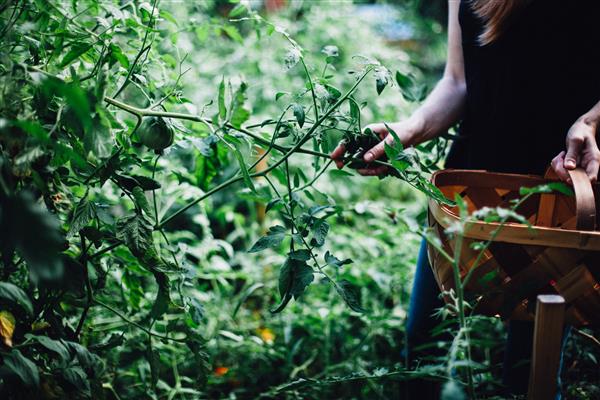
As per usual this time of year, I’ve been spending morning and afternoon hours in my garden. We start it early, sprouting the seeds indoors or in the cold frames and watch them grow up big and strong in our window sills. We plot out our beds and section off space for all of the “babies” we’re making room for (and we always seem to underestimate). We prep and build extra vertical space for the creeping climbing babes that we know will just elbow their way into everyone else’s space (I’m eyeing you, spaghetti squash). We unload the compost from the previous year into the sleeping soil and we sometimes till it all up in there until it’s good and revived. It’s always so satisfying fluffing the warm soil in our hands and mushing it under our feets when it’s freshly tilled, teaming with nutrients and the earth worms are gloriously happy. It’s ready.

When I’m in the garden, prepping, planting, harvesting and crunching on fresh veggies, it’s impossible for me not to feel intimately connected to the source that’s feeding me, and the relationship between my own body and the soil that nourishes it. At a conference I was attending 2 weeks ago, an analogy was made that our own body needs to be nourished just like our soil. And that really resonated with me. Our microbiota is our terrain, and if we don’t tend to it like we would our fertile garden soil, it will produce equally malnourished results. If you don’t understand the importance of our gut macrobiota – let me simplify. Our microbiotia is “the ecological community of commensal, symbiotic, and pathogenic microorganisms that literally share our body space”. It’s the probiotics, the bacteria, the bugs, the nutrients, and even yeasts (saccharomyces) that collectively, and ideally harmoniously, make up a huge part of our health and a few pounds in our gut space.
Findings from the Human Microbiome Project (2008-2013) have made it clear that 90% of the cells in the human body are microbial (!) and that the genetic repertoire of these microbes is at least 150 times greater than that of our human cells. This makes us a walking ecology (much like an old growth forest), nearly 90% bacteria and only 10% cells. Which begs the question – why on earth is the go-to “treatment” now antibiotics that kill off an inordinate number of our microbiota, leaving our body & immune system wide open to disease and imbalance? An estimated 400,000 different microbial species inhabit the human gut. No more than a few 100 of these have been seen on a microscope or been cultured. Collectively, these comprise an essential metabolic and immune organ. All of these critters respond and react to everything going on inside and outside of our body, including our nutritional inputs and nutrients, our external environment / toxins and pollutants, our stress levels (hello, inflammatory cortisol!), drugs we take, alcohol we consume, physical stressors we take on and even emotional joys or traumas we experience. Nothing goes unnoticed by our gut microbiota.
When the gut microbiota is functioning well (i.e our life is in relative balance), it will support us in abundance and help to prevent chronic and acute illness, just like when our garden soil is healthy, happy and nutrient rich, it will produce amazingly nutritious veggies. If our microbiotia is depleted, strained and damaged, it will lead to an equally depleted and malnourished human. I’m sure you’ve seen a particularly anemic looking vegetable – weak, flaccid, lacking vibrant color and just infirm. They are a direct reflection of their soil and their growing environment – just like people. We soak up and absorb everything around us, from our soil, our sunlight, our water and our atmosphere. We are no different from the plants and vegetables that require the inputs from the earth to make us strong and vibrant. When we don’t have access to these things – we wilt and develop disease as a result.
Some of the best things we can do to nourish and support our microbiota and the circus of critters living within us is to feed ourselves healthy, whole, colorful and nutrient rich foods. Drinking pure water to stay hydrated (no wilting!). Absorbing plenty of sunlight every day. Moving our body to stay active and flexible (if a plant becomes brittle, it will break too). Making connections and being in community ourselves strengthens our emotional resolve and keeps us diverse. HENCE the connection with probiotics – the probiotics in our gut are likened to the diverse community we keep. Everything on a very small scale has a representation on the larger scale too. Supplementing with probiotics on a daily basis, or better yet eating lots of fermented foods keeps our probiotics replenished and constantly making new friends. Foods like sauerkraut, kimchi, miso, pickles, kombucha, yogurt and kefir are all great examples of probiotic rich ferments. No soil can survive without it’s bacteria and critters, and no human gut microbiota can function without this diverse ecological community of nutrients, bacteria and probiotic cultures.
So tending to our own garden should be a priority both individually, and globally. Let’s not forget that we are a direct representation of our own terrain, and how we tend to our own soil is reflective in the fruits that we sow. Take grateful advantage of the coming summer bounty, the glowing warm sun and the pure water (should we be so lucky) that hydrates our roots. Take deep breaths to calm the terrain, smile often to recharge our emotional vitality and connect deeply with the community around us to diversify our interdependence. And take a great big bite out of a freshly ripe tomato.

Photos by the ever lovely, Renee Byrd








